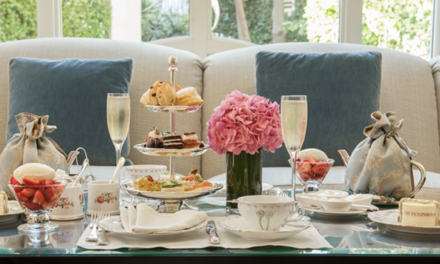
Luxe Beat Exclusive Interview: Adam Seger of The Tuck Room NYC

Opened since the beginning of November in the renovated South Street Seaport in lower Manhattan sits the unassuming Tuck Room. Step into a hidden enclave of a book lover’s heaven that is nestled on the third floor of the plush iPics movie theater and you’ll find enough artwork and cocktails to entice even the most demanding guests.
Adam Seger is a veteran in the cocktail industry, and he runs a tight ship to deliver the best cocktails, innovated food pairings (champagne & fried chicken, anyone?) and more.
We sat down with Adam to chat cocktail trends, The Tuck Room, innovation and more:
Kimberly Fisher: How did you get started in cocktails?
Adam Seger: My parents got me a blender when I was about 5, and I started to perfect banana smoothies. That was kind of my earliest thing, and I always knew I had a natural passion for cooking. My dad had been a bartender through college, and I always though there was kind of a mystique about it, and so I ended up going to Cornell (the hotel school), working in France in restaurants and going into fine dining on the hotel side of the business. Yet I was always fascinated by cocktail creation.
In 2003 at a restaurant in Chicago, we were the first place doing garden-to-glass, farm-to-bar cocktails in Chicago at that time, and were really at the forefront of craft cocktails before that was even a thing. I continued on with that, coming from more of a “chef’s lens,” more of a sommelier lens as well.
KF: You were one of the first to implement chef’s table to cocktails. How does that apply here to The Tuck Room?
AS: In the back of the green room, we actually have a little room called The Butler’s Pantry, that we use as a cocktail and champagne station, essentially a beverage version of a chef’s table. Our cocktail list is very seasonal, the produce we use is in tangent with the kitchen. Any new iPics that we open, any new restaurants, the first thing I do is sit down with the chef and see what is the menu, what produce is coming in, what spices, what specialty ingredients, what farmers we are working with locally, and the cocktail list is then created after the food menu is, so there is a seamlessness there.
KF: Where does your inspiration come from?
AS: It comes from seasons, it comes from food, comes from ingredients I come across, things I eat…
KF: What are some of your favorite ingredients?
AS: I love passion fruit, Thai basil, maple syrup, and I especially like a wood-fired maple syrup I’ve discovered; the sap is reduced with wood so you get a faint smokiness to it. I love mescal. Also, Amaros, the bittersweet liqueurs from Italy. Those are spirits that have anywhere from 30-100 or so different ingredients/botanicals to flavor them. You can add 30-100 different botanicals from nature to a cocktail from just one ingredient.
KF: Where do you think the next trend in mixology is going?
AS: Seasonal has been going on for a couple of years, I see that continuing even more. I’m seeing that just as restaurants designate farms on their menus, I am seeing more with cocktail lists. Seeing a lot more local and craft spirits, and also using things like local honey or herbs from a particular farmer’s market. I also see a big growth in aperitif wines; vermouths are especially huge. If you go and look at classic cocktails pre-prohibition, more than 50% of them contain either bittersweet or dry vermouth. Not much attention has been paid to that ingredient, but now, because we recognize that vermouth is such a big part of a classic cocktail, you are seeing bars pay more attention to the quality and freshness.
With the aperitif wines, I am finding more consumers that are looking for lower-ABV-percentage cocktails. They want to have a drink or a cocktail and aren’t looking for just a beer or glass of wine, but not a really boozy martini. They want to have something a little lower alcohol. Even a trend with a reverse martini, where instead of the majority being gin and just a touch of vermouth, instead having the majority be vermouth with the gin or the vodka. You are still getting the sophistication of a martini, but a little more wine-base-forward and a little less alcohol.
KF: What do you think are some of the more sophisticated drinks?
AS: Champagne cocktails are one of the most elegant. If done well, champagne is one of my go-to beverages. The European tradition of starting off a meal or an afternoon with an aperitif, I think is just so elegant. Rather than going straight for that big alcohol drink, it’s having something that is going to open up your appetite, very botanical forward, which I love. Having cocktails and spirits that have a lot of things from Mother Nature in them are great…they go back centuries and centuries with herbs, roots, spices and leaves that are gathered and preserved in the spirit. With all of these different natural botanicals going on, it stimulates your mind as well, and almost all of those traditions go back to early botanical medicines. If you look at a vermouth formula and look at every ingredient, they had to do with antioxidants, anti-inflammatories, things that helped with circulation, things that helped with digestion; and aperitifs besides being elegant, had a purpose.
KF: What do you drink in your off time?
AS: Roeder Champagne. Really good beer, mainly local. So if I travel, I like to drink as locally as possible. I want to try things that I can’t necessarily get at home.
KF: What’s one place in the world that has really impacted the way you practice mixology?
AS: The two at the beginning of my career would have been Lab Bar in London. You can trace a bulk of trend-setting bars in London back to Lab Bar. It was kind of the nucleus that had 30 seats and 6 bartenders on, and tasting every single cocktail before it went out to the guests, and now it’s become part of the norm. Another place that had a big influence was 28 Hong Kong Street in Singapore; they are in a part of the world where cocktail culture is quite new and drinking spirits is new. Because there is not a cocktail history per se in Singapore, they don’t suffer from traditions or rules. They don’t have a preconceived notion, and their creativity is especially inspiring. They are certainly looking at what the top bars are doing in London, the U.S, etc.. but they are very much their own and not tied to tradition.
KF: What trends do you hope go away?
AS: I think people that are so brand-centric, so that they won’t try something else. I certainly respect that, but something can also be said for trying new things. For instance, a person comes in and says, “I don’t like gin.” Well, maybe they hadn’t had gin in 10 years, or it was in a horribly made cocktail. Or they only drink a certain kind of vodka, but won’t try anything locally. With millennials driving so much of the beverage trends, I think that is changing. They are constantly asking, “What’s next” and “What’s new”.
KF: Speaking of the millennial trend, how do you work with their needs at the bar?
AS: Here we do two infusions a night, they change everyday. So, at minimum we have two new things we have never done before. It’s engineered into our program. We have several bartenders that work together on it, so it’s a collaboration, sometimes inspired by the season, the farmer’s market, current events, holidays, movies. That always keeps it really fresh.
One fun thing that we do on Thursday nights is called Drunken Doughnuts. Three different kinds of donut holes (crispy cream, old-fashioned, double-glazed Valrona chocolate) with five dipped sauces. We do the sauces from scratch. We make our own Dulce de Leche and spike that with 101 proof bourbon; we make fresh whipped cream with 151 proof vodka; we make boozy ice cream table-side with nitrogen–and one of bartenders, Christine, makes jam every week that we spike, and we also do a chocolate sauce spiked with cognac and dark rum. We try to be fun and unpretentious, and take away the snobbery. We call it Vinyl, Funk & Donut Thursdays. That’s about an unpretentious as you can get.
KF: Where do you see The Tuck Room going?
AS: Right now we are still in that discovery phase. You tell someone that you are a bar on the third floor of a movie theater, a lot of people don’t expect a creative, cutting-edge cocktail program where we are. It’s been really exciting as people discover us, and we find that we are getting busier every single week, because as people come and discover us, we have a very high repeat factor.
When guests come here, they also want to be that person who says, “Hey, I discovered this cool spot.” Then, when they realize they can go to a movie, and have the same cocktails, not only can you bring them to the movie, but you press a button and it can be delivered to them. Then it really all just comes together.
I see nothing for us but continuing to grow and get bigger. At the end of the day, we are a bar. We want to be the neighborhood bar. We also want to be a destination. Lower Manhattan was really where cocktail culture started in New York City. When people come to New York, I want them to say, “I want to go to Dead Rabbit, I want to go to Blacktail, I want to go to Tuck Room.” We want to be a part of that.














![7 Refreshing Cocktails with a Kick! [COCKTAIL TIME]](https://luxebeatmag.com/wp-content/uploads/2021/08/The-Garden-Party_Side-440x264.jpg)























